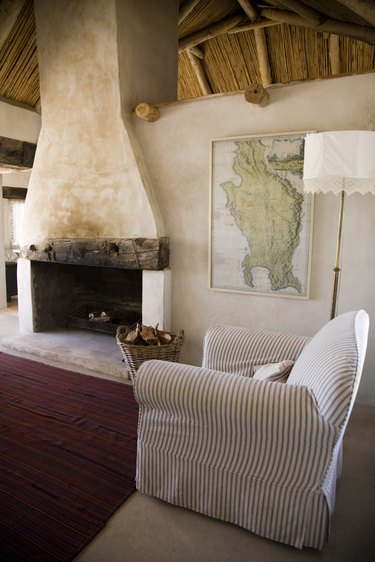
Chimneys are a common sight in many homes. They can have a rustic or a modern look, and while they do serve as a design element for a room, they also serve the more practical role of helping to heat a home during the colder months. Even with proper maintenance, however, certain problems can emerge. Among these is the appearance of "sweat" -- that is, finding small amounts of drops and rivulets of water on the outer walls. A sweating chimney is usually the result of either condensation or leaking.
Condensation
Video of the Day
When warm, moist air comes into contact with a colder surface, the gaseous water in the air has its energy reduced and is converted to its liquid state, a process called condensation. A classic example of condensation is the water found on the outside of the glass of a cold drink during a warm summer day. This same process can happen with a chimney. During the times when there is no fire lit, cold air from the outside can cool down the chimney walls.
Video of the Day
Sweating as a Result of Condensation
If the air inside the home is warm and humid and the walls of the chimney are cold, this can result in sweating. When the warm air of the house comes into contact with the cold wall that separates the living space from the chimney, water from the air will condense onto the wall's surface. The resulting droplets of water will flow downwards in small rivulets, making the chimney appear as though it is sweating.
Sweating as a Result of Leaks
Condensation can also occur within the chimney; the walls of the chimney can take time to warm up, so when a new fire is lit, the hot exhaust air from the fire will come into contact with the cold walls of the chimney, and condensation will occur. If the heat from the exhaust is not enough to subsequently make the water evaporate, the water will remain even after the fire is put out.
Incoming cold air from the outside will freeze the water. Since water expands when it freezes, it can damage the walls of the chimney, particularly if they are made of a very porous material such as brick. This repeated freezing and thawing results in small cracks that will allow water to be drawn from inside the chimney to the exterior through capillary action.
Damage to the walls can also be the result of chemicals from the exhaust being diluted into the water formed by condensation, producing a corrosive mixture that will also work to damage the interior of the chimney, eventually resulting in leaky cracks.
Preventing Sweating
A good flue liner will help to thermally isolate the walls of the chimney from the air of the chimney, which means that the walls of the chimney will not cool down as quickly, and less condensation will occur on the exterior of the chimney. A good flue liner will also heat up much faster, helping to prevent condensation in the interior of the chimney.
A quality chimney covey is also important to allow for proper venting of the exhaust from the chimney, thus helping to prevent moisture buildup within the chimney while still preventing any rainwater from entering the chimney.